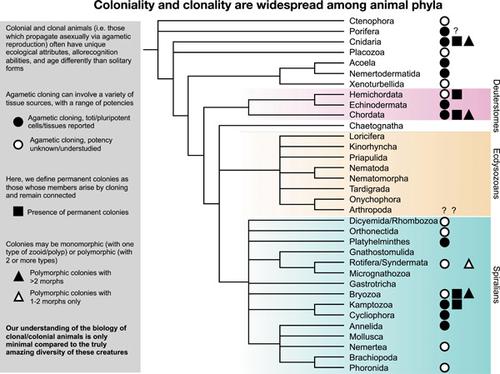当前位置:
X-MOL 学术
›
J. Exp. Zool. B Mol. Dev. Evol.
›
论文详情
Our official English website, www.x-mol.net, welcomes your feedback! (Note: you will need to create a separate account there.)
Coloniality, clonality, and modularity in animals: The elephant in the room
Journal of Experimental Zoology-B: Molecular and Developmental Evolution ( IF 2.2 ) Pub Date : 2020-04-19 , DOI: 10.1002/jez.b.22944 Laurel S Hiebert 1, 2 , Carl Simpson 3 , Stefano Tiozzo 2
Journal of Experimental Zoology-B: Molecular and Developmental Evolution ( IF 2.2 ) Pub Date : 2020-04-19 , DOI: 10.1002/jez.b.22944 Laurel S Hiebert 1, 2 , Carl Simpson 3 , Stefano Tiozzo 2
Affiliation

|
Nearly half of the animal phyla contain species that propagate asexually via agametic reproduction, often forming colonies of genetically identical modules, that is, ramets, zooids, or polyps. Clonal reproduction, colony formation, and modular organization have important consequences for many aspects of organismal biology. Theories in ecology, evolution, and development are often based on unitary and, mainly, strictly sexually reproducing organisms, and though colonial animals dominate many marine ecosystems and habitats, recognized concepts for the study of clonal species are often lacking. In this review, we present an overview of the study of colonial and clonal animals, from the historic interests in this subject to modern research in a range of topics, including immunology, stem cell biology, aging, biogeography, and ecology. We attempt to portray the fundamental questions lying behind the biology of colonial animals, focusing on how colonial animals challenge several dogmas in biology as well as the remaining puzzles still to be answered, of which there are many.
中文翻译:

动物的殖民性、克隆性和模块化:房间里的大象
近一半的动物门包含通过无配子繁殖无性繁殖的物种,通常形成基因相同模块的群体,即分株、动物或息肉。克隆繁殖、集落形成和模块化组织对生物体生物学的许多方面都有重要影响。生态学、进化和发展理论通常基于单一的、主要是严格有性繁殖的生物体,尽管群居动物主导着许多海洋生态系统和栖息地,但通常缺乏研究克隆物种的公认概念。在这篇综述中,我们概述了殖民地和克隆动物的研究,从该学科的历史兴趣到一系列主题的现代研究,包括免疫学、干细胞生物学、衰老、生物地理学和生态学。
更新日期:2020-04-19
中文翻译:

动物的殖民性、克隆性和模块化:房间里的大象
近一半的动物门包含通过无配子繁殖无性繁殖的物种,通常形成基因相同模块的群体,即分株、动物或息肉。克隆繁殖、集落形成和模块化组织对生物体生物学的许多方面都有重要影响。生态学、进化和发展理论通常基于单一的、主要是严格有性繁殖的生物体,尽管群居动物主导着许多海洋生态系统和栖息地,但通常缺乏研究克隆物种的公认概念。在这篇综述中,我们概述了殖民地和克隆动物的研究,从该学科的历史兴趣到一系列主题的现代研究,包括免疫学、干细胞生物学、衰老、生物地理学和生态学。


























 京公网安备 11010802027423号
京公网安备 11010802027423号